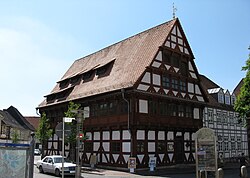Gifhorn
| Gifhorn | ||
|---|---|---|

Old town hall
|
||
|
||
| Coordinates: 52°29′19″N 10°32′47″E / 52.48861°N 10.54639°ECoordinates: 52°29′19″N 10°32′47″E / 52.48861°N 10.54639°E | ||
| Country | Germany | |
| State | Lower Saxony | |
| District | Gifhorn | |
| Government | ||
| • Mayor | Matthias Nerlich (CDU) | |
| Area | ||
| • Total | 104.86 km2 (40.49 sq mi) | |
| Elevation | 50 - 68 m (−173 ft) | |
| Population (2015-12-31) | ||
| • Total | 41,905 | |
| • Density | 400/km2 (1,000/sq mi) | |
| Time zone | CET/CEST (UTC+1/+2) | |
| Postal codes | 38501–38510, 38516, 38518 | |
| Dialling codes | 05371 | |
| Vehicle registration | GF | |
| Website | www.stadt-gifhorn.de | |
Gifhorn (German pronunciation: [ˈɡɪfhɔʁn]) is a town and capital of the district of Gifhorn in the east of Lower Saxony, Germany. It has a population of about 42,000 and is mainly influenced by the small distance to the more industrial and commercially important cities nearby, Brunswick and Wolfsburg. Further, Gifhorn is part of the Hanover-Brunswick-Göttingen-Wolfsburg Metropolitan Region.
The oldest verifiable source attests the existence of the city in the year 1196.
Gifhorn is home to the International Wind- and Watermill Museum, which contains a comprehensive collection and working replicas of the world's most common windmills.
Gifhorn lies at the confluence of the Rivers Ise and Aller. Gifhorn is situated about 20 km (12 mi) north of the city of Brunswick and about 15 km (9 mi) west of Wolfsburg. In the city, the Bundesstraße 4 and 188 meet. At the northern end of the city, the Lüneburg Heath starts.
Gifhorn was first mentioned in 1196. It was located at the crossing of two then important merchant routes: The salt street (German: Salzstraße) being a main trading route for salt between Lüneburg and Brunswick, and the grain street (German: Kornstraße) transporting grain between Celle and Magdeburg.
Schools in Gifhorn include the Humboldt Gymnasium, the Otto-Hahn-Gymnasium, Fritz-Reuter-Realschule, Dietrich-Bonhoeffer-Realschule, Albert-Schweitzer-Hauptschule and the Berufsbildenden Schulen I and II. Alfred-Teves-Schule, which was called Volksschule Süd between 1954 and 1958, was open between 1954 and 2010.
...
Wikipedia


